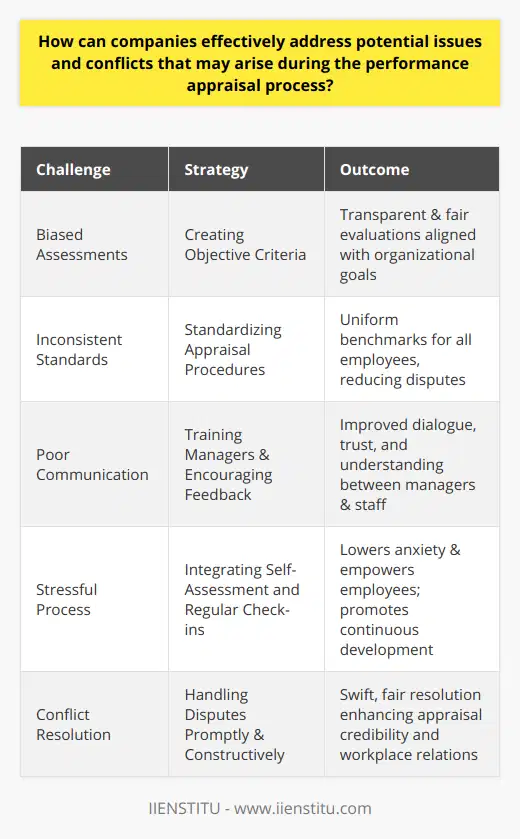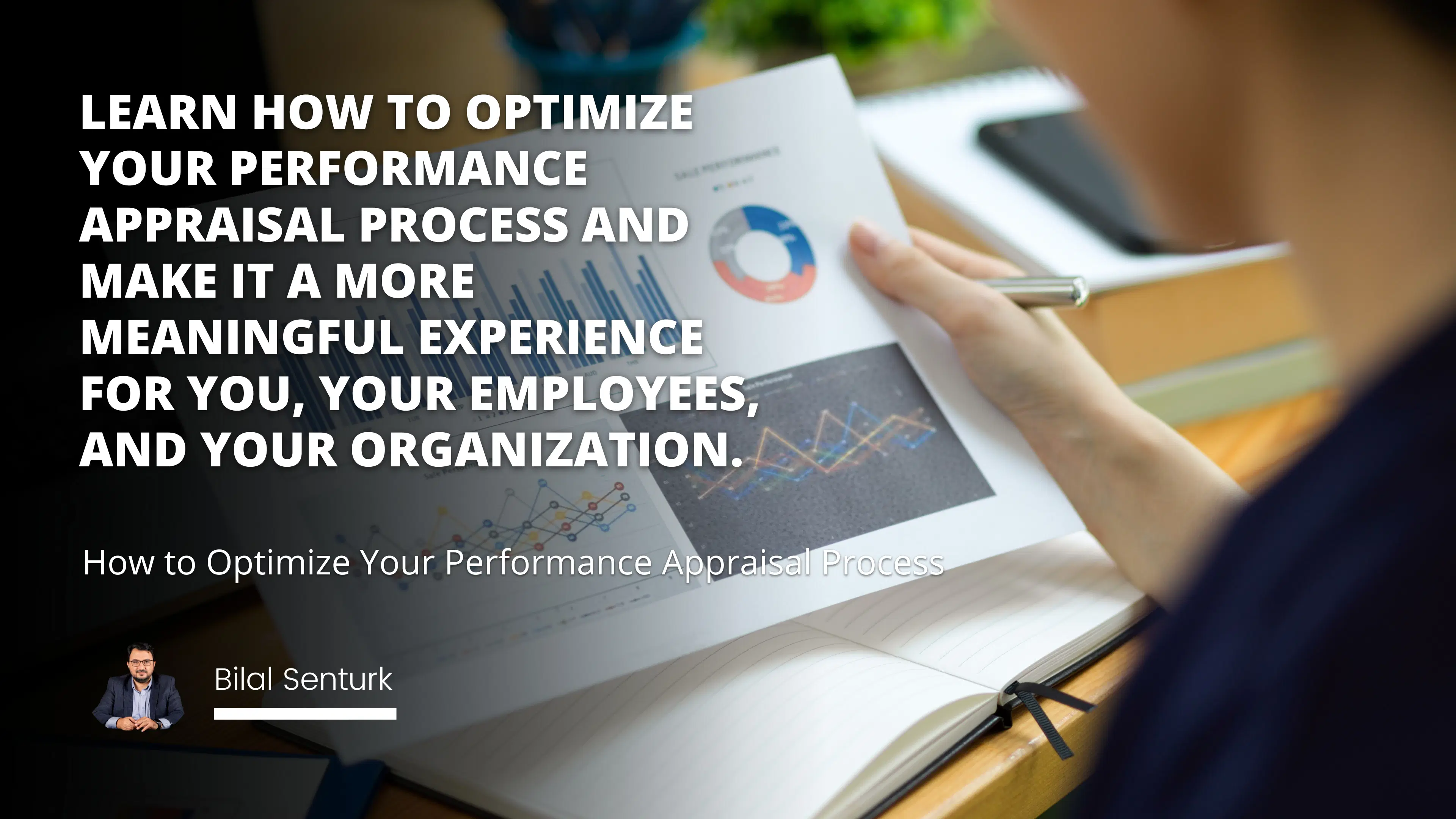
Turning Performance Appraisals from Dreaded Chores into Valuable Tools
I still remember my first performance appraisal like it was yesterday. My palms were sweaty, my heart raced, and I couldn't shake the feeling that every flaw in my work over the past year would be under a microscope. Like many employees, I dreaded the annual appraisal, viewing it as a necessary evil rather than a constructive conversation. However, over the years, I've come to realize that when done right, performance appraisals can be a powerful tool for both personal growth and organizational success.
In today's fast-paced business world, performance management isn't just about ticking boxes or filling out forms—it's about fostering an environment where employees and managers work together towards common goals. Let's explore how we can transform the performance appraisal process into a meaningful experience that drives organizational success.
Understanding the True Goals of Performance Appraisals
At its core, the performance appraisal process is designed to assess an employee's contributions and identify areas for improvement. But beyond that, it's an opportunity to align individual objectives with the company's vision. According to Armstrong's Handbook of Performance Management, performance appraisals should be a continuous dialogue that promotes engagement and motivation (Armstrong, 2017).
So, what are the fundamental goals of this process?
1- Enhancing Communication: Regular appraisals open lines of communication between managers and employees, fostering trust and transparency.
2- Identifying Strengths and Weaknesses: By assessing performance, managers can recognize exceptional work and address any areas that need development.
3- Aligning Objectives: Appraisals ensure that individual goals are in sync with the company's strategic direction.
4- Facilitating Growth: They provide a platform for discussing career aspirations and professional development opportunities.
Setting Clear and Measurable Objectives
One of the most critical steps in effective performance management for managers is establishing clear, measurable objectives. I recall working on a project where the goals were vague, leading to confusion and frustration among team members. We realized that without defined targets, it's impossible to measure success or provide meaningful feedback.
Here’s how to set impactful objectives:
Specific: Clearly define what needs to be accomplished.
Measurable: Establish criteria to measure progress.
Achievable: Ensure the goals are realistic with available resources.
Benefits Administration: Comprehensive Insights and Best Practices
Variable Pay: An In-depth Look at Modern Compensation Strategies
Relevant: Align objectives with organizational priorities.
Time-bound: Set deadlines for achievement.
This is often referred to as the SMART framework, a concept detailed in Management: Tasks, Responsibilities, Practices by Peter Drucker (Drucker, 1974). By applying this framework, managers can create a roadmap that guides employees toward success.
Collecting Feedback Throughout the Year
Waiting until the annual performance review to give feedback is like only checking your car's oil once a year—it's not effective and can lead to problems down the line. Continuous feedback is crucial for keeping employees on track and engaged.
Strategies for ongoing feedback include:
Regular Check-ins: Schedule bi-weekly or monthly meetings to discuss progress and address concerns.
Open-door Policy: Encourage employees to voice their thoughts at any time.
360-Degree Feedback: Utilize input from peers, subordinates, and other departments to get a holistic view of performance.
In the book Thanks for the Feedback by Douglas Stone and Sheila Heen, the authors emphasize the importance of receiving feedback graciously and using it for growth (Stone & Heen, 2014). By fostering a culture where feedback is welcomed and acted upon, organizations can enhance overall performance.
Utilizing Standardized Appraisal Forms
To ensure consistency and fairness, it's essential to use a standardized performance review template. This not only streamlines the process but also ensures that all employees are evaluated against the same criteria.
Benefits of a standardized form include:
Consistency: Provides a uniform structure that all managers follow.
Clarity: Outlines specific areas of assessment.
Efficiency: Saves time by eliminating the need to create new forms for each appraisal.
Remember to customize the template to reflect the unique needs of your organization. In The Handbook of Performance Management, it's suggested that templates should be flexible enough to adapt to various roles yet structured enough to maintain consistency (Bacal, 2012).
Assigning Fair and Accurate Ratings
It's crucial to assign a fair and accurate rating to employee performance. Biases, whether conscious or unconscious, can lead to incorrect assessments and affect employee morale.
Tips for unbiased evaluations:
1- Use Objective Data: Base ratings on measurable outcomes whenever possible.
2- Be Aware of Biases: Reflect on any preconceived notions that may influence your judgment.
3- Seek Multiple Perspectives: Incorporate feedback from various sources to balance your view.
4- Document Performance Regularly: Keep records of achievements and areas needing improvement throughout the year.
Fair evaluations are essential not just for employee satisfaction but also for legal compliance. The Employment Law for Human Resource Practice highlights the importance of consistent and fair appraisal processes to prevent discrimination claims (Bennett-Alexander & Hartman, 2019).
Documenting Feedback and Providing Written Justification
When it comes to performance and management, documentation is your best friend. Providing written feedback ensures that there's a clear record of discussions, expectations, and decisions made during the appraisal.
Effective documentation should:
Be Specific: Clearly outline what was discussed, including examples.
Highlight Achievements: Recognize and record accomplishments.
Address Areas for Improvement: Provide constructive criticism with suggestions for development.
Include Employee Input: Allow employees to add their comments or rebuttals.
Underlining the importance of documentation, Performance Appraisal and Management by Kevin R. Murphy notes that thorough records can help track progress over time and inform future appraisals (Murphy, 2020).
Turning Appraisals into a Positive Experience
It's possible to turn the annual appraisal into a positive, even anticipated, event. Here's how:
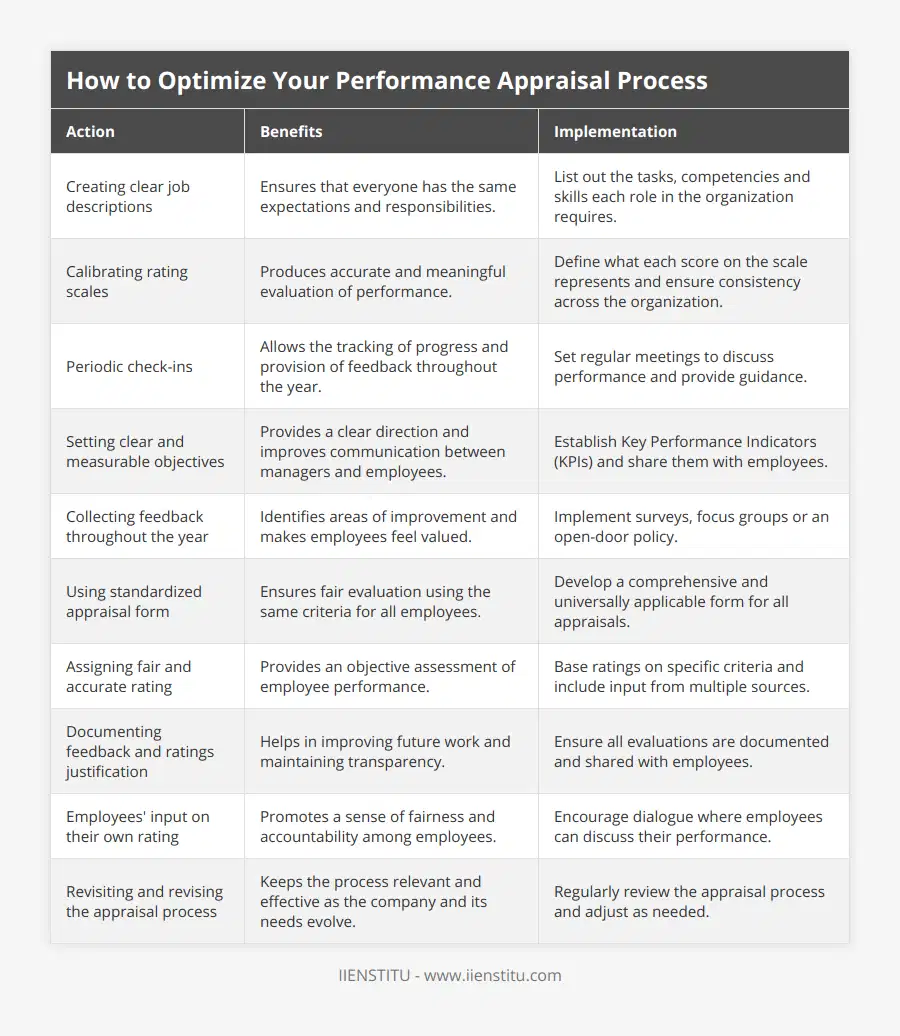
Prepare in Advance: Both managers and employees should come ready to discuss specific topics.
Focus on Development: Emphasize growth opportunities rather than just evaluating past performance.
Set Collaborative Goals: Work together to set objectives for the coming year.
Celebrate Successes: Take time to acknowledge and appreciate achievements.
I once worked with a manager who transformed our department's appraisal process. She made it a two-way conversation, encouraged honest dialogue, and always highlighted our team's contributions to the company's success. This approach not only improved our performance but also boosted morale.
The Role of Performance Management in Organizational Success
Effective performance mgmt is integral to achieving organizational goals. By managing for performance, companies can enhance productivity, foster employee engagement, and drive profitability.
Key aspects include:
Alignment: Ensuring individual objectives support broader company goals.
Engagement: Keeping employees motivated and invested in their work.
Development: Providing opportunities for learning and advancement.
Accountability: Holding everyone responsible for their performance.
In The Fundamentals of Management, Robbins and Coulter discuss how performance management systems are vital for implementing strategies and achieving competitive advantage (Robbins & Coulter, 2018).
Conclusion
Performance appraisals don't have to be a source of stress. With the right approach, they can become a valuable tool for both employees and managers. By setting clear objectives, providing continuous feedback, utilizing standardized templates, and assigning fair ratings, organizations can turn the perf review process into a catalyst for growth.
If you're interested in delving deeper into HR appraisal strategies and enhancing your skills in performance management, I invite you to join our comprehensive course on HR management. Together, we'll explore proven techniques and innovative approaches to take your appraisal process to the next level.
References
Armstrong, M. (2017). Armstrong's Handbook of Performance Management: An Evidence-Based Guide to Delivering High Performance. Kogan Page Publishers.
Bacal, R. (2012). The Manager's Guide to Performance Reviews. McGraw-Hill.
Bennett-Alexander, D. D., & Hartman, L. P. (2019). Employment Law for Human Resource Practice. Cengage Learning.
Drucker, P. F. (1974). Management: Tasks, Responsibilities, Practices. Harper & Row.
Murphy, K. R. (2020). Performance Appraisal and Management. Sage Publications.
Robbins, S. P., & Coulter, M. (2018). Management. Pearson.
Stone, D., & Heen, S. (2014). Thanks for the Feedback: The Science and Art of Receiving Feedback Well. Penguin Publishing Group.
By embracing these practices, you're not just improving the employee appraisal process—you're investing in your team's success and, ultimately, the future of your organization.
Frequently Asked Questions
What strategies can I use to ensure my performance appraisal process is effective?
Clearly define goals and objectives for each employee: Make sure each employee understands what is expected of them and what performance targets need to be met.
Set measurable, achievable goals: Set goals that are realistic and measurable so that progress can be tracked and success can be evaluated.
Encourage feedback: Invite employees to provide feedback on their performance and goals, so that you can make sure you're on track and identify areas for improvement.
Utilize data: Make sure you're using data to inform your performance appraisals, such as metrics or surveys.
Offer support: Provide employees with resources and support to help them reach their goals and optimize their performance.
Regularly review performance: Schedule regular performance reviews to ensure that employees are on track with their goals and objectives.
Provide rewards and recognition: Offer rewards and recognition for excellent performance to motivate employees and create a positive work environment.

How can I ensure that my performance appraisal process is fair and unbiased?
Ensure that performance appraisals are conducted on a regular basis.
Train managers on how to provide constructive feedback in a fair and consistent manner.
Develop clear criteria for performance ratings and expectations.
Incorporate objective measures of performance in the assessment process.
Allow employees to provide feedback on their performance as part of the appraisal process.
Use multiple raters for each employee to ensure fairness and consistency.
Provide opportunities for employees to discuss their performance with their manager in a supportive environment.
Regularly review the appraisal process to ensure fairness and accuracy.
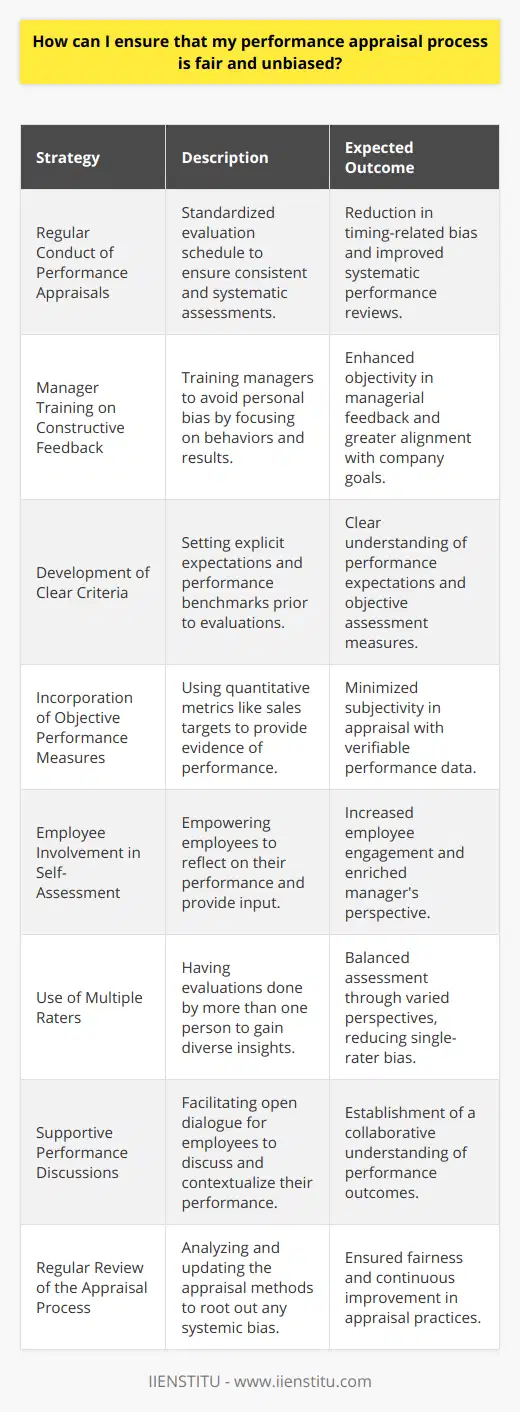
What tips can I use to make my performance appraisal process more meaningful for my employees?
Give your employees ample time to fill out the self-assessment portion of the appraisal.
Ask for feedback from employees about the process and adjust it as needed.
Ensure that the appraisal process is fair, consistent and unbiased.
Focus on employees' strengths, progress and successes rather than weaknesses.
Set clear expectations of employee performance and results.
Ask employees open-ended questions to gain a better understanding of their performance.
Provide direct, honest feedback to employees throughout the appraisal process.
Make sure to document all performance reviews with clear, accurate notes.
Offer employees the opportunity to discuss the appraisal and provide feedback.
Aim to make the process as positive and constructive as possible.

How do you optimize a performance management system?
Establishing Clear Goals
To optimize a performance management system, it is crucial to establish clear, specific, and measurable goals. This will ensure that employees are aware of what is expected from them and create a basis for performance evaluation.
Utilizing Key Performance Indicators (KPIs)
Monitoring KPIs helps in analyzing an employee's performance, providing a quantitative assessment of their progress. Identifying relevant KPIs and setting benchmarks will facilitate the optimization of the performance management system by enabling informed decision-making.
Emphasizing Feedback and Communication
Frequent feedback and robust communication are critical to the successful optimization of a performance management system. Providing constructive feedback allows employees to identify areas for improvement, while open communication channels foster engagement, trust, and understanding between managers and employees.
Implementing Learning and Development Opportunities
Optimizing a performance management system requires investing in learning and development opportunities for employees. By offering training, skill development, and opportunities for growth, organizations can enhance employee performance, improve retention rates, and ensure a highly skilled workforce.
Encouraging Employee Engagement
Actively involving employees in the development and implementation of performance management systems contributes to their optimization. When employees feel their opinions are valued and that they have a stake in the process, they are more likely to be engaged, resulting in higher levels of performance.
Leveraging Technology
The use of technology can streamline the performance management process by offering real-time data, automating routine tasks, and providing various tools for goal setting, feedback, and employee development. By leveraging technology, organizations can improve the efficiency and effectiveness of their performance management systems, enhancing their overall optimization.
Regularly Reviewing and Updating the System
Lastly, it is essential to revisit and update the performance management system continuously. Reviewing the system on a regular basis allows organizations to make changes that reflect evolving goals, address identified gaps or issues and keep pace with the ever-changing business environment.
In conclusion, optimizing a performance management system can be achieved by incorporating clear goals, utilizing KPIs, emphasizing feedback and communication, investing in employee development, encouraging engagement, leveraging technology, and regularly reviewing the system. These strategies ensure the system remains relevant and well-suited to promote enhanced employee performance within the organization.

What are the 5 steps in effective performance appraisal?
Establishing Performance Standards
The first step in an effective performance appraisal process involves establishing performance standards, which are developed from an organization's goals and objectives. These standards should be specific, measurable, achievable, relevant, and time-bound (SMART).
Communicating Expectations
Once performance standards have been developed, it is crucial to communicate these expectations to employees. This ensures a clear understanding of what is expected of them and helps foster a sense of accountability. Regular communication and feedback also contribute to the employee's motivation and engagement in their work.
Monitoring and Evaluating Performance
Managers should consistently monitor and evaluate employee performance throughout the appraisal period. This may involve regular meetings, progress reports, or informal check-ins. Monitoring helps to identify areas where performance can be improved and provides opportunities for coaching and development. Evaluation should involve assessing the employee's results against the established performance standards.
Providing Feedback and Coaching
Providing timely and specific feedback is essential in the performance appraisal process. Managers should address both areas of strength and areas in need of improvement. Effective feedback should be constructive and include specific suggestions for how performance can be improved. Coaching and development opportunities should also be offered to help employees achieve their performance goals.
Conducting Formal Performance Appraisals
The final step in the process involves conducting a formal performance appraisal, where the employee's performance is discussed and documented. This is typically done on an annual or semi-annual basis and should include a comprehensive review of performance throughout the appraisal period. The appraisal should address the employee's achievements, areas for improvement, and future goals. Appraisals also provide an opportunity to discuss reward and recognition programs, which might include promotions, pay increases, or bonuses.
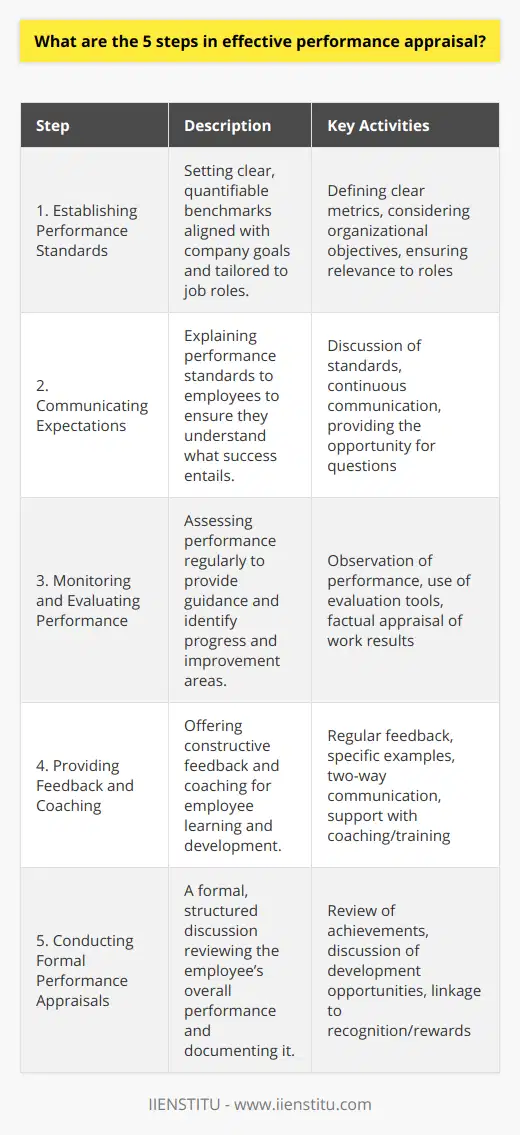
What are key success factors for optimum performance appraisals?
Critical Evaluation and Feedback
One of the key success factors for optimum performance appraisals lies in the critical evaluation of an employee's performance and the provision of constructive feedback. A performance appraisal should showcase a comprehensive analysis of the employee's strengths, weaknesses, opportunities for improvement, and potential risks.
Goal Alignment and SMART Objectives
Another critical aspect involves aligning personal goals and objectives with those of the organization. Management should ensure employees have SMART (specific, measurable, achievable, relevant, and time-bound) objectives, which are linked to the company's overall strategic plans. This alignment fosters accountability, highlights employee contributions, and establishes clear expectations for performance.
Employee Involvement and Ownership
Performance appraisals should incorporate employee involvement and ownership to promote mutual understanding and commitment. By engaging employees in self-assessment and goal-setting, management fosters a dialogue that identifies barriers to success and recommends interventions to address performance gaps. This collaboration creates a sense of responsibility and personal investment in the process.
Focus on Employee Development
Performance appraisals should focus not only on past accomplishments but also on future growth and development. This entails identifying skill gaps, providing learning opportunities, and creating developmental plans for employees to enhance their capabilities. By emphasizing employee development, organizations can unlock potential, improve job satisfaction, and increase staff retention rates.
Continuous Feedback and Monitoring
To optimize performance appraisals, organizations should establish a culture of continuous feedback and monitoring. This approach moves beyond the traditional annual review, encouraging more frequent informal discussions and touchpoints between employees and supervisors. This dynamic communication fosters greater insights into employee performance, enables timely course-correction, and cultivates a more agile and responsive workplace.
In summary, the key success factors for optimum performance appraisals encompass critical evaluation, feedback, goal alignment, employee involvement, a focus on development, and continuous monitoring. By embracing these principles, organizations can enhance the effectiveness of their performance appraisal process, empower their employees, and ultimately, drive better organizational performance.

How would you improve the performance appraisal process?
**Establish Clear Performance Criteria**
To improve the performance appraisal process, it is essential to establish and communicate clear performance criteria. Employees should understand the expectations and goals relevant to their specific roles and responsibilities, ensuring that evaluations are objective and transparent. By outlining key performance indicators (KPIs), appraisees can better focus on their work, and appraisers can measure progress and success more accurately.
**Align Appraisal with Organizational Goals**
Linking the performance appraisal process to overarching organizational goals ensures that employees' efforts align with the company's strategic objectives. This alignment motivates employees to contribute to the organization's overall success, fostering a sense of purpose and increasing job satisfaction. Additionally, focusing on the organization's mission and vision in appraisal discussions encourages employee buy-in, enhancing engagement and loyalty.
**Regular Feedback and Communication**
Frequent feedback and open communication between managers and employees throughout the year, rather than just at the annual review period, can greatly enhance the appraisal process. Regular check-ins allow for timely course corrections, adjustments to performance targets, and prompt recognition of achievements, resulting in a more accurate and fair assessment. These iterative discussions help build trust and rapport, facilitating constructive, two-way feedback during formal appraisals.
**Focus on Employee Development**
An effective performance appraisal process should emphasize employee development, striking a balance between addressing areas of improvement and nurturing strengths. To achieve this, managers should engage in solution-focused conversations, collaboratively identifying specific actions, resources, and support needed to enhance performance. By tailoring developmental plans to individual employees, organizations can cultivate growth, increase productivity, and retain top talent.
**Utilize Multiple Evaluation Methods**
Incorporating various evaluation methods such as self-evaluations, peer reviews, and 360-degree feedback can provide a more comprehensive understanding of an employee's performance. These diverse perspectives can help identify patterns, illuminate blind spots, and minimize bias in the appraisal process. Additionally, a multi-faceted approach supports the triangulation of data, resulting in a more accurate assessment of employee performance.
In conclusion, by establishing clear performance criteria, aligning appraisal with organizational goals, promoting regular feedback and communication, focusing on employee development, and utilizing multiple evaluation methods, the performance appraisal process can be significantly improved. These enhancements ultimately foster employee satisfaction, development, and loyalty while driving overall organizational success.
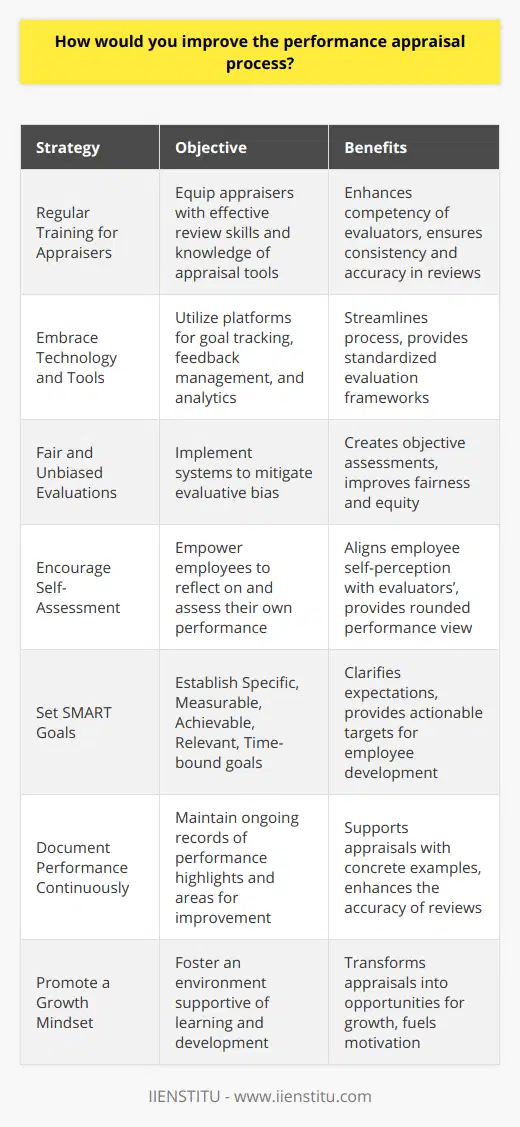
What are some best practices for setting performance goals and objectives during appraisals?
Appraisal Approach and Goal Setting
To maximize effectiveness in setting performance goals and objectives during appraisals, employers should adopt a systematic approach. This involves several crucial steps, which will be discussed in this paragraph.
Alignment with Organizational Goals
Firstly, performance goals should be aligned with the organization's overall objectives. By doing so, employees’ efforts will contribute significantly to the company's overall success and simultaneously ensure a clear understanding of their roles.
Utilizing SMART Criteria
Next, the SMART criteria should be employed when establishing performance goals. SMART stands for Specific, Measurable, Achievable, Relevant, and Time-bound. This framework ensures goals are clear, trackable, and attainable, leading to a higher likelihood of employees achieving their targets.
Involvement of Employees
Thirdly, involving employees in the goal-setting process boosts their motivation and commitment. Giving employees an opportunity to voice their opinions during appraisals increases their sense of ownership and responsibility towards the set targets.
Regular Reviews and Feedback
Moreover, frequent performance reviews and feedback sessions are essential for effective goal management throughout the appraisal process. Regular check-ins help employees identify areas for improvement and enable managers to provide timely support and guidance in achieving targets.
Recognizing and Rewarding Achievements
Finally, recognition and rewards play a significant role in motivating employees to continue performing at their highest potential. Employers should provide fair, consistent, and transparent incentives to amplify employee engagement and satisfaction with their workplace.
In conclusion, effectively setting performance goals and objectives in appraisals requires alignment with organizational goals, utilization of SMART criteria, employee involvement, regular reviews, and timely recognition and rewards. By following these best practices, employers can create a conducive environment that supports employee growth, development, and overall success.
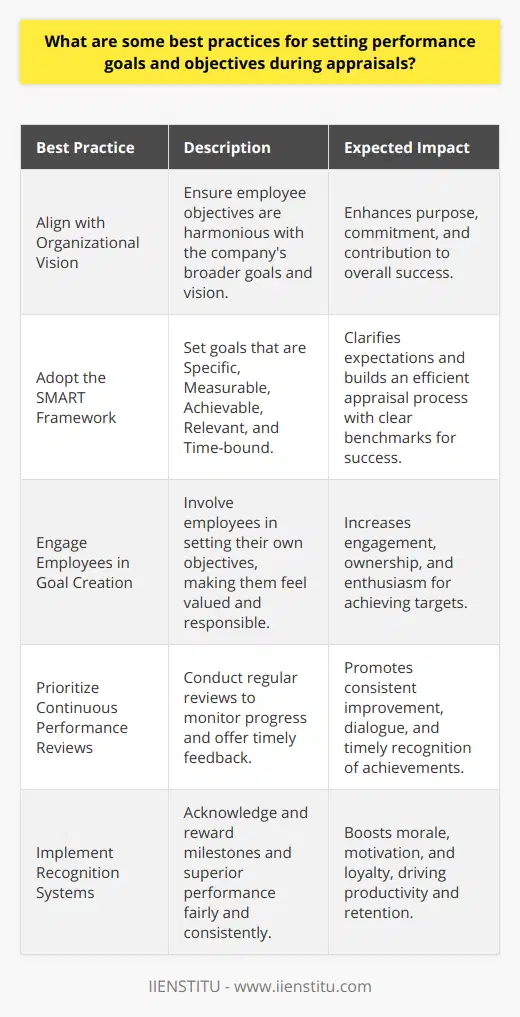
How can organizations maximize employee engagement and motivation through performance appraisal systems?
Performance Appraisal Systems and Employee Engagement
To maximize employee engagement and motivation through performance appraisal systems, organizations should focus on adopting specific strategies in the design and implementation of these systems.
Clear Objectives and Goals
Firstly, organizations need to establish clear objectives and goals for the performance appraisal process. Clearly defined expectations and performance standards enable employees to better understand their role and contribute more effectively to the organization.
Transparent and Fair Evaluation Process
The implementation of a transparent and fair evaluation process is crucial for maintaining employee engagement and motivation. Employees should be assessed based on their merit and performance, fostering trust and ensuring that performance appraisals remain a motivating factor rather than a cause of frustration and dissatisfaction.
Regular Feedback and Communication
Organizations should emphasize the importance of regular feedback and communication in their performance appraisal systems. Employees should receive ongoing feedback about their performance, both positive and constructive, enabling them to address areas for improvement and feel valued for their contributions to the organization.
Employee Development and Growth Opportunities
Performance appraisal systems should offer employee development and growth opportunities. Organizations can maximize employee engagement and motivation by offering personalized development plans, career advancement opportunities, and training programs. This approach not only improves job satisfaction but also ensures continuous learning and development within the organization.
Recognition and Rewards
Finally, an effective way to enhance employee engagement and motivation through performance appraisal systems is by recognizing and rewarding high performers. Incentives and rewards, whether monetary or non-monetary, can serve as powerful motivators and encourage employees to excel in their roles.
In conclusion, organizations can maximize employee engagement and motivation by adopting a well-designed and comprehensive performance appraisal system. By focusing on clear objectives, transparency, regular feedback, employee development, and recognition and rewards, organizations can create an environment that fosters growth, development and overall job satisfaction for their employees.
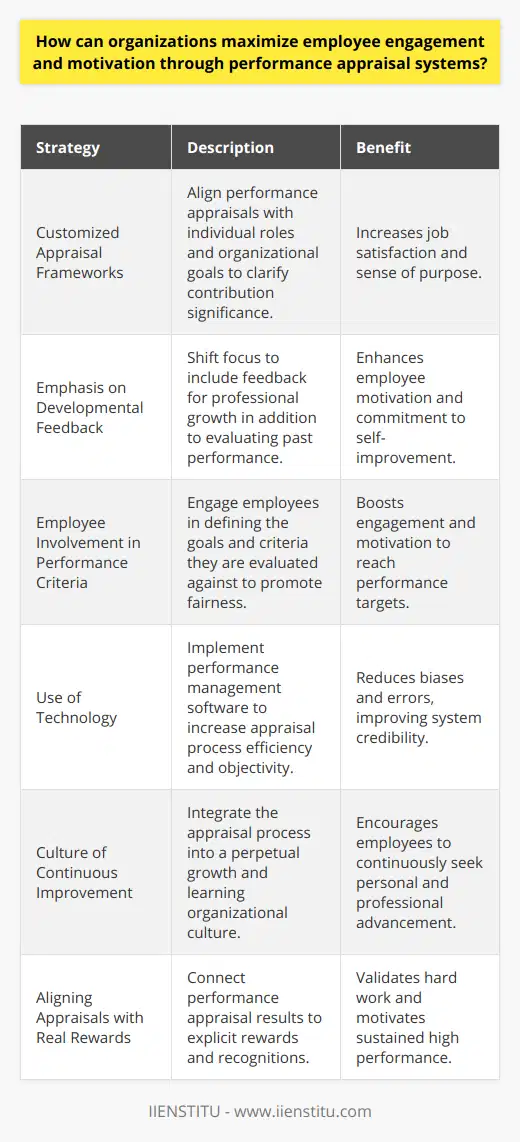
How can the integration of technology enhance the performance appraisal process?
Integration of Technology in Performance Appraisal
Enhancing Objectivity and Consistency
The integration of technology in the performance appraisal process can significantly enhance its objectivity and consistency. By employing advanced software solutions, organizations are able to create standardized evaluation frameworks and metrics, which in turn facilitates a more impartial and accurate assessment of employee performance. Furthermore, these technological tools often offer analytics and reporting functionalities, allowing managers to clearly identify trends and patterns in employee productivity and engagement.
Increasing Efficiency and Reducing Bias
Utilizing technology in the performance appraisal process can also lead to greater efficiency and reduced bias. Through automating various aspects of the evaluation process such as data collection, collation, and analysis, technology ensures that performance assessments are completed in a timely and accurate manner. Moreover, the use of advanced algorithms in the evaluation process helps eliminate potential biases or subjectivities often associated with human judgment, thus ensuring a more equitable appraisal of employee performance.
Promoting Continuous Feedback and Development
Another key advantage of integrating technology in performance appraisal is the potential to promote continuous feedback and development. Technology-enabled appraisal systems can facilitate real-time data sharing and communication between employees and supervisors, allowing for prompt identification of performance gaps or areas for improvement. This real-time feedback can foster a more supportive and collaborative working environment, thereby encouraging employees to continuously engage in self-reflection, skill-building, and professional development efforts. Such a proactive approach to employee growth is vital in driving organizational success and maintaining a competitive edge in today's dynamic business landscape.
In conclusion, the integration of technology in the performance appraisal process presents a myriad of benefits, including enhanced objectivity and consistency, increased efficiency, reduced bias, and promotion of continuous feedback and development. Organizations should therefore capitalize on technological advancements to revamp their performance appraisal systems, ultimately fostering a more positive, fair, and growth-oriented working environment.
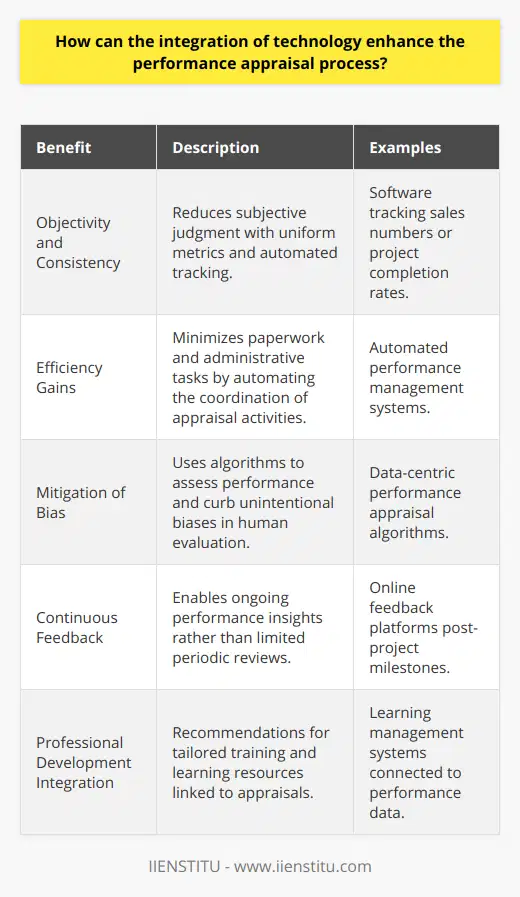
What are the potential benefits and challenges of adopting a continuous performance appraisal approach?
Potential Benefits of Continuous Performance Appraisal
Improved Employee Engagement
Continuous performance appraisal enhances employee engagement as it offers consistent feedback, leading to the development of a strong employee-manager relationship. A stronger relationship enhances employees' commitment, resulting in increased productivity and overall job satisfaction.
Timely Feedback and Goal Adjustment
Adopting a continuous performance appraisal allows for the timely identification of successes and areas that need improvement. This enables employees to receive real-time feedback, redirect their efforts as needed, and align with the company's objectives, leading to better results.
Employee Development and Growth
Through regular performance discussions, employees can identify their strengths, weaknesses, and career goals. This ongoing development process allows for tailored coaching, mentoring, and training opportunities, leading to employee growth and improved skill sets.
Challenges of Continuous Performance Appraisal
Time and Resource Constraints
While continuous appraisals promise various benefits, they can also be time-consuming for managers, who must frequently engage with employees to provide ongoing feedback. This presents a challenge, as it requires managers to allocate sufficient time and resources for effective appraisals.
Maintaining Objectivity and Consistency
Ensuring objectivity and consistency in continuous performance appraisals can be challenging, as appraisals are more frequent and informal. This can lead to biases or misinterpretations, which may impact employees' outcomes and perceptions.
Overemphasis on Short-Term Goals
Continuous performance appraisals may result in a narrow focus on achieving short-term goals, at the expense of long-term objectives. Managers must strike a balance between immediate and future needs, ensuring employees understand and adhere to the company's overall strategic plan.
To conclude, the continuous performance appraisal approach offers several potential benefits, such as increased employee engagement, timely feedback, and employee growth. However, it also presents challenges related to time and resource constraints, maintaining objectivity, and the risk of overemphasizing short-term goals. Organizations considering this approach should weigh these factors and develop strategies to mitigate challenges while maximizing benefits.
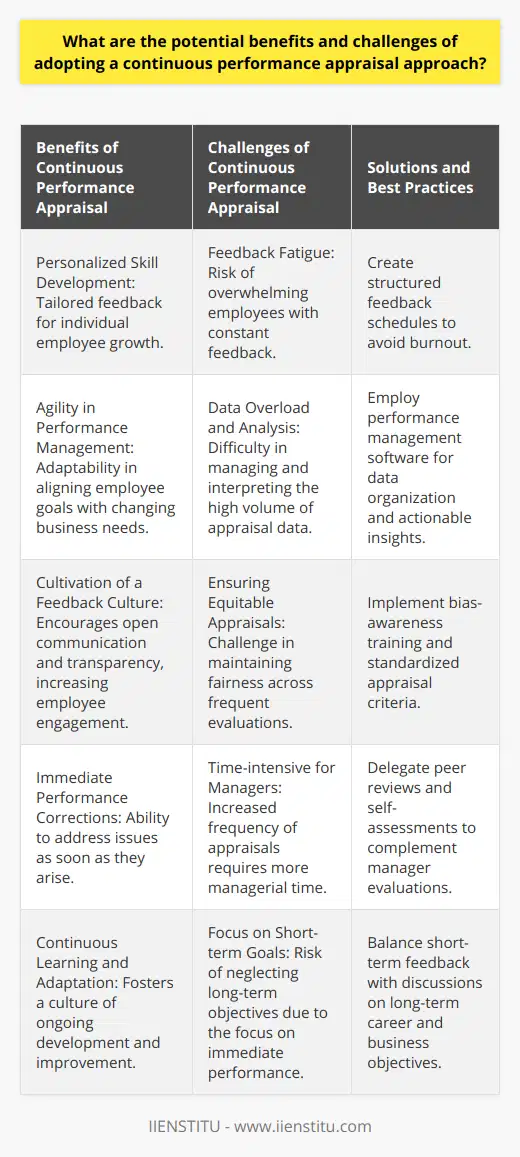
How can companies ensure alignment between employee performance appraisals and overall organizational goals and objectives?
**Linking Employee Performance with Organizational Goals**
In order to ensure alignment between employee performance appraisals and overall organizational goals and objectives, companies must take a multistep approach. Firstly, organizations should establish clear and measurable goals, which are directly linked to their long-term vision and mission. These goals should be communicated effectively to employees, ensuring that they understand how their individual performance contributes to the company's success.
**The SMART Approach to Setting Objectives**
One method for creating such goals is the SMART approach, which stands for Specific, Measurable, Achievable, Relevant, and Time-bound. By outlining objectives in this manner, employees are more likely to comprehend the expectations set forth and how their performance will be evaluated. SMART objectives remove ambiguity and provide quantifiable metrics, making it easier for employees to understand and reach their targets.
**Incorporating Organizational Goals into Performance Appraisals**
Once goals are established and communicated, it is essential to integrate them into the performance appraisal process. This can be done by using key performance indicators (KPIs) that reflect organizational objectives, and aligning them with employee appraisal criteria. By measuring employee success based on KPIs tied to overarching company goals, staff members receive feedback on how their performance impacts the organization's success.
**Fostering a Culture of Continuous Improvement**
In addition to providing feedback through assessments, organizations can support employee growth and alignment by fostering a culture of continuous improvement. This is achieved by encouraging ongoing learning and development opportunities for staff. By providing resources and support for employees to develop new skills and enhance existing ones, companies can create a workforce that is more adaptable and better equipped to meet organizational goals and objectives.
**Regular Review and Adaptation of Goals and Appraisals**
Finally, it is critical for organizations to regularly review and modify their goals, objectives, and performance appraisal processes, to ensure that they remain relevant and aligned with the evolving needs of the business. This may involve conducting periodic reviews of goals and objectives, updating KPIs, and refining performance appraisal criteria accordingly. This proactive approach helps to maintain alignment between employee success and the achievement of the company's overall targets.
In conclusion, by establishing clear goals and objectives informed by the SMART criteria, linking them to employee performance appraisals, fostering a culture of continuous improvement, and regularly reviewing and updating these objectives, organizations can ensure alignment between individual employee successes and larger organizational aims. This symbiotic relationship enhances job satisfaction, increases employee motivation, and ultimately leads to greater organizational success.
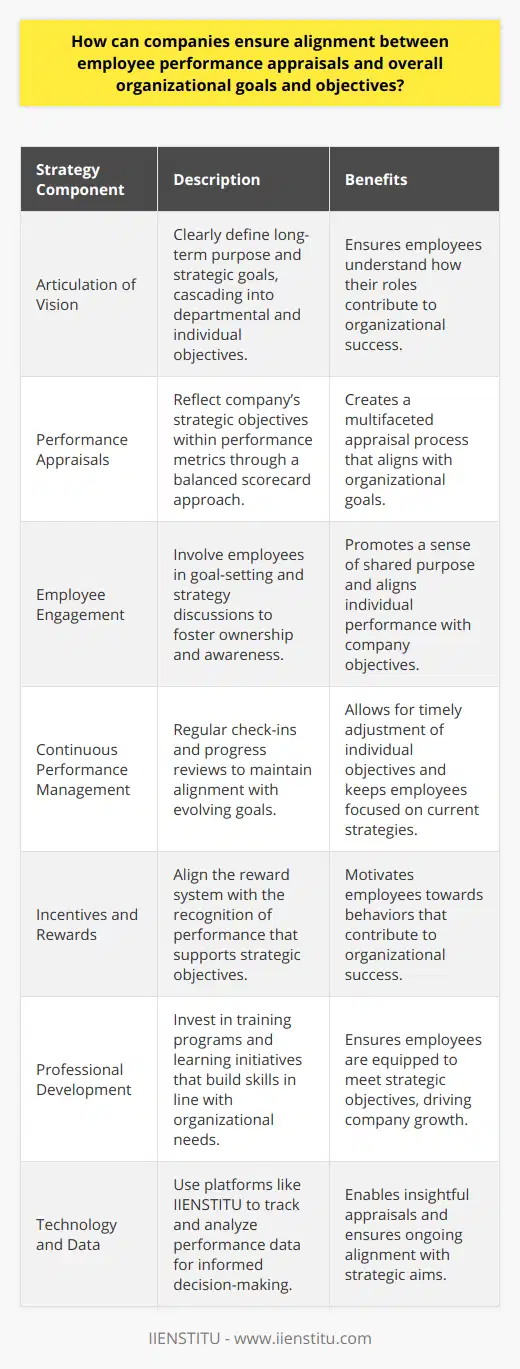
How can the incorporation of employee feedback and self-assessment improve the performance appraisal process?
Incorporating Employee Feedback
The practice of incorporating employee feedback in the performance appraisal process can considerably enhance its effectiveness. Employee feedback provides insights into their experiences, perspectives, and concerns that may not be apparent through traditional evaluation methods. By actively seeking input, management can identify areas for improvement while fostering employee engagement and satisfaction.
Self-Assessment as a Tool
Self-assessment is another essential component in refining the performance appraisal process. It serves as an opportunity for employees to gauge their strengths, weaknesses, and accomplishments accurately. Inclusion of self-assessment empowers employees to take ownership of their performance and develop a deeper understanding of their role and objectives within the organization.
Continuous Improvement
To effectively improve the performance appraisal process, continuous improvement is necessary. Encouraging employees to provide regular feedback and self-assessments enables reassessment and calibration of the evaluation criteria and methods. It ensures that the appraisal process remains relevant and adaptable to the evolving priorities of the organization.
Collaborative Approach
Adopting a collaborative approach to performance appraisals aligns individual goals with the organization's objectives. Engaging employees in the design and implementation of the appraisal process promotes a sense of responsibility and increased commitment to personal and organizational growth. This collaboration propels the development of a comprehensive appraisal process that reflects the values of both the employee and the company.
Mutual Accountability
Incorporating employee feedback and self-assessment cultivates an environment of mutual accountability. This practice encourages employees and management to establish open communication channels and actively work together to address performance issues and build on successes. Such transparency fosters trust, encourages constructive feedback, and enhances overall employee buy-in to the process.
In conclusion, incorporating employee feedback and self-assessment into the performance appraisal process creates a dynamic and adaptive method of evaluation. By doing so, employees become more engaged and accountable in their pursuit of personal and organizational objectives. This collaborative effort ensures that the appraisal process is relevant, effective, and conducive to the growth and success of both the individual and the organization.
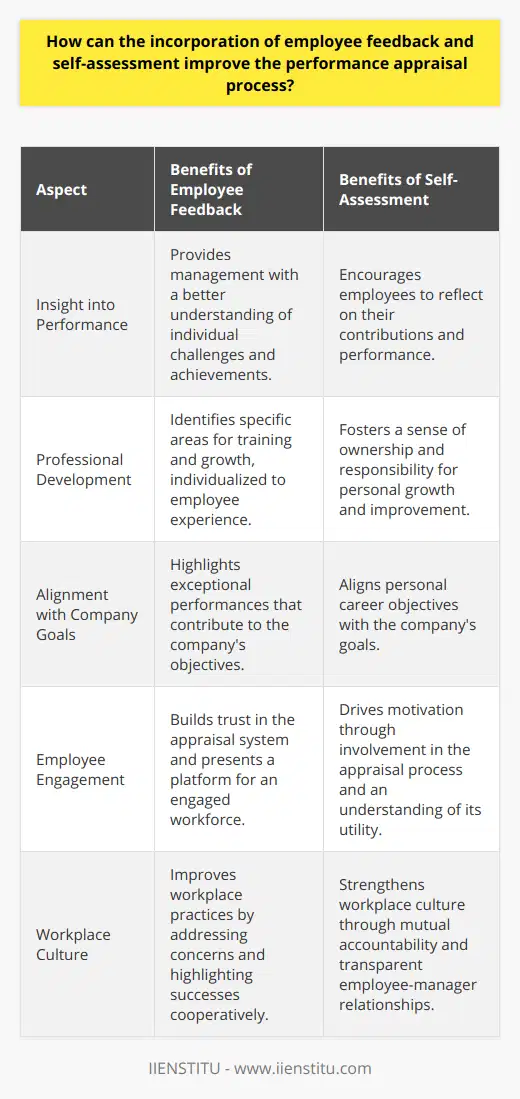
What strategies can be employed to minimize biases and enhance objectivity during performance evaluations?
Strategies to Minimize Biases
To minimize biases and enhance objectivity during performance evaluations, several strategies can be employed. These approaches aim to reduce subjectivity and promote fairness in assessing employee performance.
Use Multiple Raters
Involving multiple raters, such as supervisors, peers, and subordinates, can provide diverse perspectives on an employee's performance. This approach reduces individual biases and leads to a more comprehensive evaluation.
Establish Clear Criteria
Setting clear performance criteria, aligned with organizational goals, ensures consistency in evaluating employees. This method helps prevent vague or subjective assessments and enables employees to understand expectations.
Implement Training Programs
Conducting training programs for evaluators enables them to recognize and manage both conscious and unconscious bias. By promoting awareness of personal biases, evaluators can improve their impartiality and objectivity.
Provide Regular Feedback
Ongoing communication and feedback throughout the year prevents recency bias, a tendency to focus on recent events instead of the entire performance period. This process allows for timely recognition and addressing of performance issues.
Adopt Consistent Rating Scales
Using consistent rating scales for all employees establishes a standard for measuring performance. This method reduces biased interpretations of performance outcomes and variability in evaluations.
Separate Performance from Personality
Evaluators should focus on employee performance and accomplishments, rather than personal traits or characteristics. By distinguishing performance from personality, evaluators can better concentrate on objective assessments.
Consider Job Context
Evaluators should take into account job-specific factors, such as an employee's limited resources or challenging environments. This consideration allows for a more equitable assessment of performance and reduces unfair comparisons between employees.
Review Performance Evaluations
Regular review and analysis of performance evaluations can identify potential biases or patterns of subjectivity. Monitoring evaluations ensures ongoing improvement in objectivity and fairness.
In summary, minimizing biases and enhancing objectivity during performance evaluations is crucial for promoting a fair and inclusive workplace. By implementing these strategies, organizations can effectively assess employee performance and drive continuous improvement.
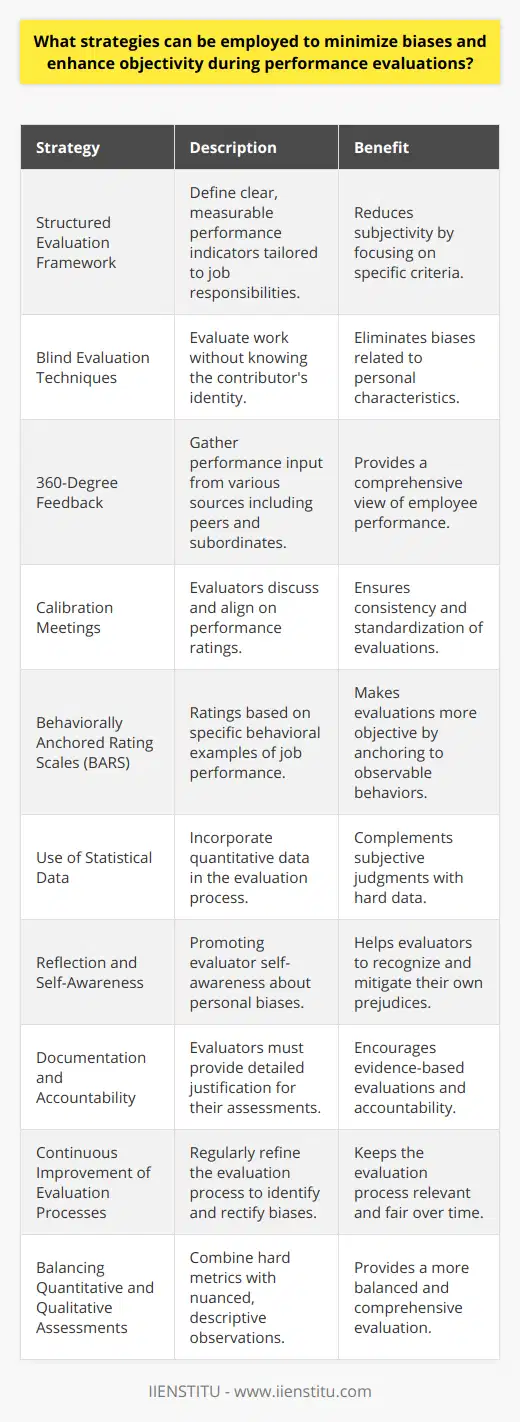
How can companies effectively address potential issues and conflicts that may arise during the performance appraisal process?
Identifying Issues in Performance Appraisal Process
To effectively address potential issues and conflicts that may arise during the performance appraisal process, companies should first identify the common problems associated with it. Some of these issues may include biased or subjective evaluations, inconsistent application of standards, and lack of communication between managers and employees.
Establishing Clear Evaluation Criteria
Developing clear evaluation criteria can help minimize subjectivity in performance appraisals. By having objective and measurable standards, evaluators can provide more accurate and fair assessments of an employee's performance. Companies should ensure that employees are aware of these criteria and that the evaluation process remains consistent across all levels and departments.
Training Managers in Appraisal Techniques
In addition to having clear evaluation criteria, companies should invest in training managers in effective appraisal techniques. This includes educating managers on the importance of avoiding biases, such as the recency effect, where recently observed behaviors have a greater impact on the evaluation, and the halo effect, where an employee's overall performance is influenced by one exceptional trait or incident. Proper training can help managers conduct a more accurate and impartial assessment.
Fostering Open Communication
One of the critical elements in addressing potential conflicts in the performance appraisal process is fostering open communication between managers and employees. Companies should encourage a continuous feedback culture, where employees feel comfortable discussing their performance and seeking clarification or improvements. Regular check-ins and meetings can help facilitate this communication, ensuring that employees feel heard and understood throughout the process.
Including Self-Assessments
Incorporating self-assessments into the performance appraisal process can provide valuable insight into an employee's perspective on their performance. This allows employees to have a role in the evaluation process, fostering a sense of ownership and collaboration. Self-assessments are also an opportunity for managers to gain a better understanding of an employee's strengths, weaknesses, and aspirations.
Addressing Conflicts Promptly and Fairly
Despite taking preventive measures, conflicts may still occur during the performance appraisal process. Companies should address any disputes promptly, ensuring a fair and transparent resolution process. This may involve mediation, the opportunity for employees to rebut evaluations, or the involvement of an unbiased third party. Properly addressing conflicts can help maintain a positive work environment and reaffirm the value placed on employees' contributions.
In conclusion, effectively addressing potential issues and conflicts within the performance appraisal process requires a combination of clear evaluation criteria, proper managerial training, open communication, self-assessment, and prompt conflict resolution. Implementing these strategies can contribute to a more transparent, accurate and fair appraisal process for all employees.
